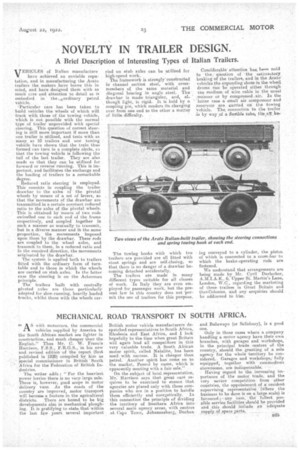NOVELTY IN TRAILER DESIGN.
Page 25

If you've noticed an error in this article please click here to report it so we can fix it.
A Brief Description of Interesting Types of Italian Trailers.
VEHICLES of Italian manufacture V have achieved an enviable repu tation, and in manufacturing the Arato
trailers the makers have borne this in mind, and have designed them with as ranch tare and attention to detail as is embodied in thess;ordinary petrol vehicle.
1Particular care has been taken to build vehicles the wheels of which will track with those of the towing vehicle, which is not possible with the normal type of trailer unprovided with special steering. This question of correct steer ing is still more important if more than one trailer is utilized, and tests with as many as 10 trailers and one towing vehicle have shown that the train thus formed can turn in a complete circle, as that the towing vehicle is following the tail of the last trailer. They are also made so that they can be utilized for forward or reverse running. This is im
portant, and facilitates the exchange and the loading of trailers to a remarkable degree.
Reduced ratio steering is employed. This consists in coupling the trailer drawbar to the axles of the pivotal wheels by means of a set of levers, so that the movements of the drawbar are transmitted in a certain constant reduced
ratio to the axles of the pivotal wheels. This is obtained by means of two rods
swivelled one to each end of the frame respectively, and coupled' together in such a manlier as mutually to transmit, but in a diverse manner and iti the same proportion, the movements imposed upon them by the drawbar. These rods are coupled to the wheel axles, and transmit to them, in a reduced ratio and in the required direction, the movements originated by the drawbar.
The system is applied both to trailers fitted with the ordinary form of turn table and to those in which the wheels are carried on stub axles. In the latter case the steering is on the Ackerman principle. The trailers built with centrally pivoted axles are those particularly adapted for slow-running, heavily loaded trucks, whilst those with the wheels car ried on stub axles can be utilized for high-speed work.
The framework is strongly constructed in channel section steel, with crossmembers of the same material and diagonal bracing in angle ateel. The drawbar is maths triangular, and, although light, is rigid. It is held by a coupling pin, which renders its.changing over from one end to the other a matter of little, difficulty.
The towing hooks with which tne trailers are provided are all fitted with stout springs and are self-closing, so that there is no danger of a drawbar becoming detached accidentally. The trailers are made in many different types suitable for all classes of work. In Italy they are even employed for passenger work, but the present law in this country does not 'permit the use of trailers for this purpose.
Considerable attention has. !seen mid to the question of the satimaetory, braking of the trailers, and in the Arato vehicles the expanding shoes in the wheel. drums Can be operated either through the medium of wire cable in the usual ,ma niter or by compressed.. air. In the ' 'latter ease a small air compressor and .reservoir are earried on the towing vehicle. The, connection to the trailer is by way ,pi a flexible tube, tiv,4.,be!.
jog conveyedto a cylinder, the piston of which is connected to a cross-bar to which the brake-operating rods are fastened.
We understand that arrangements are being made by Mr. Cyril Durlacher, A.M.I.A.E., 6, Upper St. Martin's Lane, London, W.C., regarding the marketing of these trailers in Great Britain and theAColonies, and any enquiries should be addressed to him.


































